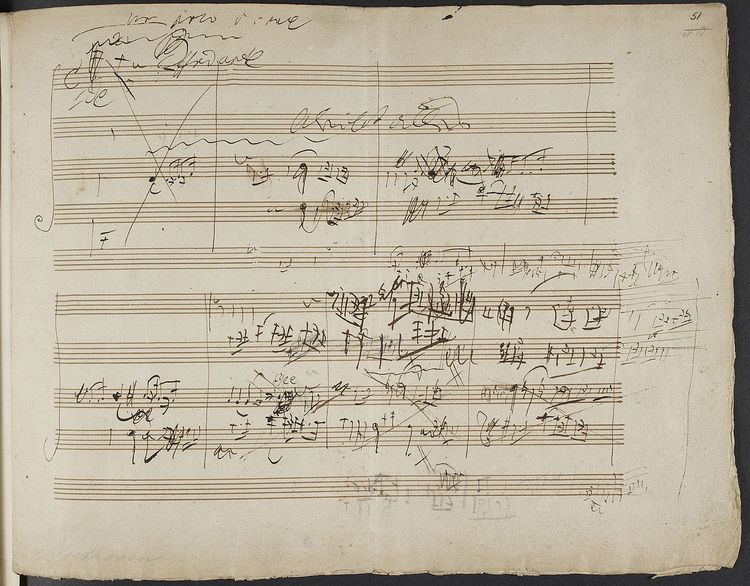 | ||
The String Quartet No. 14 in C♯ minor, Op. 131, was completed by Ludwig van Beethoven in 1826. It is the last-composed of a trio of string quartets, written in the order op. 132, 130 (with the Große Fuge ending), 131.
Contents
- Movements
- I Adagio ma non troppo e molto espressivo
- II Allegro molto vivace
- III Allegro moderato Adagio
- IV Andante ma non troppo e molto cantabile Pi mosso Andante moderato e lusinghiero Adagio Allegretto Adagio ma non troppo e semplice Allegretto
- V Presto
- VI Adagio quasi un poco andante
- VII Allegro
- Analysis
- References
It was Beethoven's favourite of the late quartets: he is quoted as remarking to a friend that he would find "a new manner of part-writing and, thank God, less lack of imagination than before". It is said that upon listening to a performance of this quartet, Schubert remarked, "After this, what is left for us to write?" Robert Schumann said that this quartet and Op. 127 had a "...grandeur [...] which no words can express. They seem to me to stand...on the extreme boundary of all that has hitherto been attained by human art and imagination."
This work is dedicated to Baron Joseph von Stutterheim as a gesture of gratitude for taking his nephew, Karl, into the army after a failed suicide attempt.
Movements
About 40 minutes in length, it consists of seven movements played without a break, as follows:
- Adagio ma non troppo e molto espressivo (121 bars, , about 7 minutes) in C-sharp minor
- Allegro molto vivace (198 bars, 6
8, about 3 minutes) in D major - Allegro moderato – Adagio (11 bars, , about 45 seconds) in B minor
- Andante ma non troppo e molto cantabile – Più mosso – Andante moderato e lusinghiero – Adagio – Allegretto – Adagio, ma non troppo e semplice – Allegretto (286 bars counting the repeats, 2
4, about 14 minutes) in A major - Presto (545 bars counting the repeats, , about 5 1⁄2 minutes) in E major
- Adagio quasi un poco andante (28 bars, 3
4, about 2 minutes) in G-sharp minor - Allegro (388 bars, , about 6 1⁄2 minutes) in C-sharp minor
I. Adagio ma non troppo e molto espressivo
A fugue based on the following subject, which contains (bars 2-3) the second tetrachord of the harmonic minor scale, the unifying motif of Beethoven's last string quartets:
Richard Wagner said this movement: "reveals the most melancholy sentiment expressed in music".
II. Allegro molto vivace
A delicate dance in compound duple meter in the key of D major, in compact sonata form based on the following folk-like theme:
III. Allegro moderato – Adagio
In the spirit of recitativo obbligato following the key of B minor; the modulation from B minor to E major functions as a short introduction to:
IV. Andante ma non troppo e molto cantabile – Più mosso – Andante moderato e lusinghiero – Adagio – Allegretto – Adagio, ma non troppo e semplice – Allegretto
This, the central movement of the quartet, is a set of 7 variations (6 complete and 1 incomplete, with coda) on the following simple theme in A major shared between the first and second violins:
This movement is the apotheosis of the 'Grand Variation' form from Beethoven's late period.
V. Presto
In E major, this is a brilliant scherzo (though in duple rather than triple time), based on the following simple idea:
VI. Adagio quasi un poco andante
In G♯ minor, this movement is in bar form with a coda, which serves as a slow, sombre introduction to:
VII. Allegro
The finale is in sonata form and returns to the home key of C♯ minor. The first subject has two main ideas:
and
The violent rhythm in this subject is contrasted with the soaring, lyrical second theme:
Analysis
The Op. 131 quartet has been described as a monumental feat of integration. While Beethoven composed the quartet in six distinct key areas, the work begins in C♯ minor and ends in C♯ major. The Finale directly quotes the opening fugue theme in the first movement in its second thematic area. This type of cyclical composition was avant-garde for a work of that period. Joseph Kerman wrote: "blatant functional reference to the theme of another movement: this never happens".
Op. 131 is often grouped with Opp. 132 and 130. There is motivic sharing among the three works. In particular, the "motto" fugue of the leading tone rising to the tonic before moving to the minor sixth and then dropping down to the dominant is an important figure shared by these works. This intervallic material is descendent from Bach, and has been used by other notable composers, including Haydn and Mozart.
This quartet is one of Beethoven's most elusive works musically. The topic has been written about extensively from very early after its creation, from Karl Holz, the second violinist of the Schuppanzigh Quartet, to Richard Wagner, to contemporary musicologists today. One popular topic is a possible religious/spiritual genesis for this work, supported by similarities to the Missa Solemnis. In the first movement of Op. 131, the continually flowing texture resembles the Benedictus and the Dona Nobis Pacem from the earlier work. In addition, whether purposefully or not, Beethoven quotes a motivic figure from Missa Solemnis in the second movement of the quartet.
The piece was featured in the plot of the 2012 film A Late Quartet. The piece is also featured in the Band of Brothers episode "Why We Fight".
